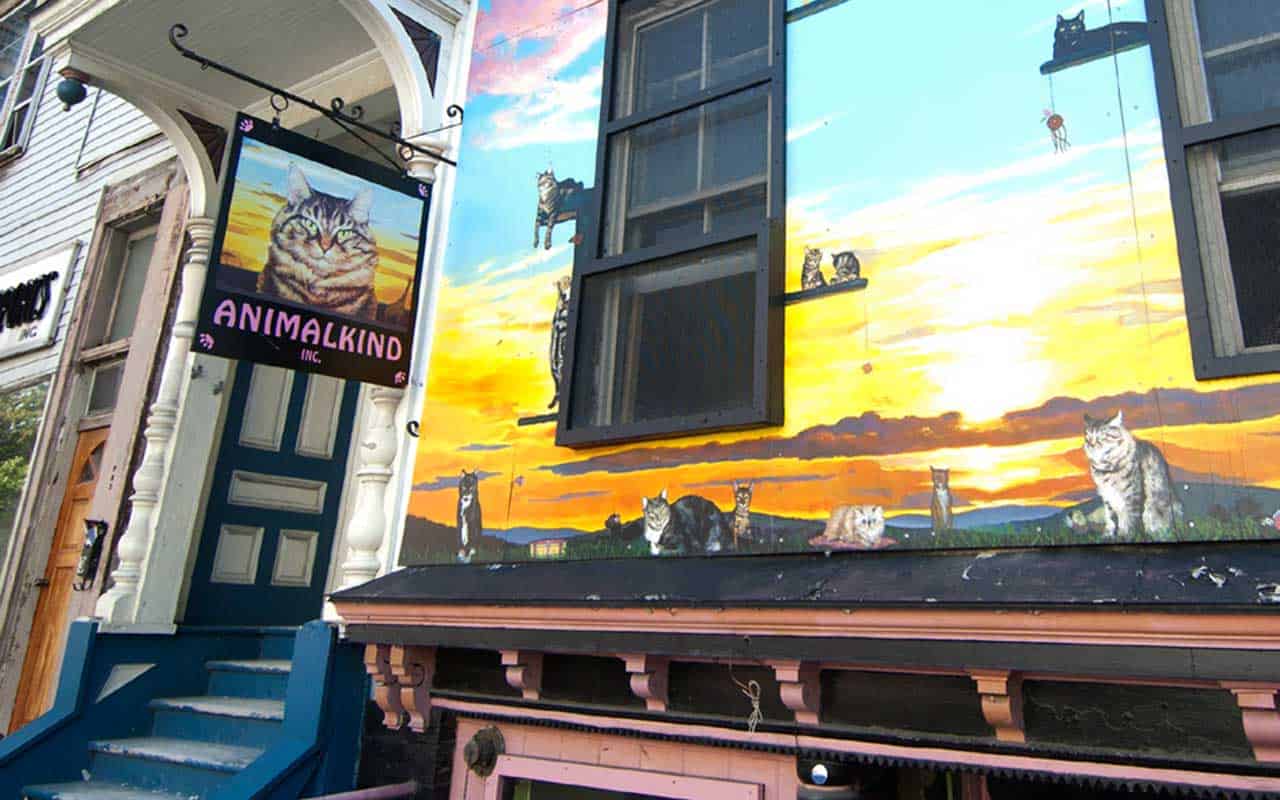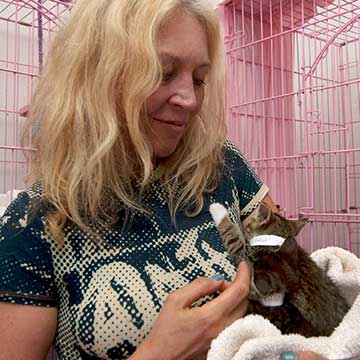This Month’s Featured Article

AnimalKind
 Based on information published by the ASPCA (American Society for the Prevention of Cruelty to Animals), 6.3 million companion animals, mostly dogs and cats, enter US shelters every year. Even more sobering, “Each year, approximately 920,000 shelter animals are euthanized (390,000 dogs and 530,000 cats).” These unsettling numbers, gathered in part by Shelter Animals Count, a collaboratively compiled database initiated in 2012, are nonetheless an improvement over past years’; in 2011 twice as many shelter animals were euthanized.
Based on information published by the ASPCA (American Society for the Prevention of Cruelty to Animals), 6.3 million companion animals, mostly dogs and cats, enter US shelters every year. Even more sobering, “Each year, approximately 920,000 shelter animals are euthanized (390,000 dogs and 530,000 cats).” These unsettling numbers, gathered in part by Shelter Animals Count, a collaboratively compiled database initiated in 2012, are nonetheless an improvement over past years’; in 2011 twice as many shelter animals were euthanized.
The overall decline in euthanasia owes much to an increase in pet adoptions – nearly four million, or two-thirds of the those entering shelters annually – and to a rise in the number of lost pets being reunited with their families. Microchips for animal identification, patented in 1985 by AVID in southern California, were first implanted in 1989, and now they are a standard, non-surgical, painless mainstay of veterinary practice. That said, there is currently “no government institution or animal organization [that] is responsible for tabulating national statistics for the animal protection movement.” The latest, 2019, figures compiled by Shelter Animals Count represent a sizeable accomplishment, dependent as they are on voluntary self-reporting. And the kindness of strangers.
Rescue, care, and adoption
For many years my husband and I attended Met Live HD performances at Time & Space Ltd. in Hudson, NY, which as many readers of this magazine know is a river town that was a commercial hub before river and rail traffic all but disappeared. Having survived the ups and downs of whaling, ironworks, brickworks, knitting mills, cement plants (the last one closed in 1975) – Hudson survived much hardship and has settled into symbiosis with artists and entrepreneurs. By the time we were driving north from Millbrook, Hudson was climbing back, clinging to the rockface of respectability, becoming a magnet for shops, restaurants, galleries, and refugees from Brooklyn.
On upper Warren Street, near the town square, we noticed a brownstone and its inviting sign: a handsome tabby cat and, underneath in pink lettering, “AnimalKind.” Its purpose was the rescue, care, and adoption of another group of refugees: the abandoned, injured, abused, or lost cats who were filling the town’s many alleyways. (This feature of the town’s grid street plan has been preserved since the 18th century, paradoxically, sometimes poverty supports historic preservation). We filled out an adoption application, and then one Sunday weeks later, with friends who’d agreed to be “godparents,” we stopped by to check on “our” cat, raced to a performance of Don Pasquale, and returned just before closing to adopt our mostly Russian Blue, whose shelter name, Smedley, we changed to Homer. With the exception of his nose leather’s top line, shaped like a sweetheart neckline, he was already a live replica of the bronze statuette from the Met’s Egyptian collection, a classic.
The one and only Katrin Hecker
I first met AnimalKind’s founder, Katrin Hecker, while adopting Homer. Everyone has a story, and hers is as rich with surprises as it is with unflinching commitment.
Katrin, you are a heroine here in Hudson, it seems to me and many others. But you are not from this area, not even close. Please explain.
I was born in Karl-Marx-Stadt (now Chemnitz) in what was then East Germany, which was under communist control. My family had applied repeatedly for visas to leave, and we finally did, for political reasons, in 1979, ten years before the Berlin Wall came down. We immigrated to West Germany, and in 1982 I became a pediatric nurse, working for several years at Altona Children’s Hospital in Hamburg. My plan was to be a nurse in Africa, but I had learned only Russian in East Germany. So, I came to New York, alone, with the intention to learn English.
And eventually you began following other interests, specifically in fashion and painting, with a stint in advertising. When did you move to Hudson?
I met my late husband, Avis Davis, a rock musician – he died two years ago – and in 1995 we moved to a 9,000-square-foot deconsecrated church in Hudson. I was planning to launch a clothing line but immediately began seeing cats roaming the streets. At first I thought the people here must really like cats, but then I began seeing that the cats – kittens, feral cats, all sorts – were emaciated, injured, pregnant, hungry. The local humane society was euthanizing every cat it could catch back then, but I didn’t believe in killing as a solution. I took in cats that were friendly, rehabilitated sick ones, and found them homes, including my own.
It sounds as if you instinctively threw all your energy into their care.
First I started feeding them, driving my motorcycle through Hudson’s alleys, where 30-60 cats were living on every alley block. I started using TNR – trap, neuter, return – to stop the breeding cycle of these unwanted, neglected cats. In the very beginning, I had seen a black cat with only three legs and a bad eye infection. He was my first trapped cat, and I named him Lucky. He was the real founder of AnimalKind. Eventually I took a dozen black cats home, putting them in my painting studio. The idea was that I’d let one cat out at a time to run around and explore, with my husband thinking I had only one. That worked until we had a power outage, and the cats found their way to the fireplace where we were sitting. It was very funny; he thought his mind was playing tricks on him when the “same” black cat multiplied before his eyes!
Were there already any organized community efforts you could partner with to control the cat population? To keep them alive when possible and care for them?
No. No one was assisting this feline population when I arrived. The cats were tolerated, abused, ignored. Catskill Animal Hospital [in Catskill, NY] was most helpful, however. After spending too much money of my own in the early years, I started AnimalKind in 2000. It was my husband who thought of the name. He had his own work but was very supportive of my decisions. Really, he had no choice!
AnimalKind is more than two decades old. I’m tempted to rephrase that to say you’ve / it has survived for 20-plus years. I cannot imagine how demanding the work must be for the staff, the volunteers, you… all the hard life-and-death calls, the constant stresses.
Well, that’s a lot, isn’t it? I can say that in that time we have rescued approximately 20,000 cats and kittens, done 40,000 spay/neuter surgeries. I am proud of everyone who helped in those efforts. My staff of ten, our three vets, we are energized by remembering the animals we have saved.
AnimalKind is a 501(c)(e) nonprofit, and of course money is always needed, for medicines, cleaning, utilities, salaries, rescue expenses. And then, each new day, that concern has to recede while you do the work. We have one or two fundraising auctions and a fashion show annually. The auctions are easier: limited input, optimal outcome.
I am always thinking about the dedication of our staff who go into some of the saddest situations for both animals and people, and still [there is] joy seeing the impact of our hard work firsthand. Then, after animals are rescued, a lot of work goes into their care. They need food and shelter, but also routine medical care, vaccinations, and enrichment activities. Rescue never stops; it is 24/7. What we get back is the heartening feeling when the rehabilitated cats find loving homes.
It has occurred to me several times as we’ve talked that abandoned or abused dogs do not figure much, at least in Hudson, in this crisis of animal welfare. How do you explain that?
Comparatively speaking, we do not have a lot of stray dogs in NYS. Municipal funding cuts have increased their number, but most lost or abandoned dogs are quickly retrieved by dog control officers and taken to shelters that have contracts. AnimalKind will attend a dog in an emergency, then contact the appropriate services.
The bigger picture for dogs is a very mixed bag. In the US, there are more stray dogs in the West and South than elsewhere. And I work with fervent rescue advocates, of both dogs and cats, in Syria, Lebanon, even Costa Rica. But Mexico has the most stray dogs in Latin America and Asian countries also have large populations of homeless, mistreated dogs.
In any depressed or unstable economy, pets in low-income neighborhoods have lower neutering and higher pregnancy rates. AnimalKind works with and for the most under-privileged pet owners, offering in addition to the services already mentioned pet-food banks and emergency boarding. But that does not explain the canine-feline disparity. There is frankly a prejudice against cats as aloof or “independent” creatures, and we are a dog-oriented society in love with “man’s best friend,” etc. Homeless cats are also harder to catch than dogs are. It’s complicated. Some people may believe that cats are better able to live “free” on the streets, but this is of course untrue. They suffer just as any animal would from lack of food, shelter, health care, and affection.
What can you tell me about “kill shelters?” I have read that they are more prevalent in the South, and I know there are groups that bring shelter animals north in customized buses to escape those places.
Many shelters say they are not “kill shelters,” when in fact they are. And, yes, the South has a higher euthanasia rate. It’s the small print one needs to pay attention to. “We do not kill for space” is the most common misleading statement. Many such shelters will kill for often arbitrary standards of behavior or age. One should always ask about these policies when surrendering an animal to a shelter.
AnimalKind has a clear policy on euthanasia. We do not euthanize animals for space, age, or any other reason that is not strictly medical, when the animal is in pain and unable to be rehabilitated. We do not believe in killing feral cats. They are not prime candidates for adoption, of course, but they are brilliant “workers” (mousers) in rural settings. Altered feral cats can live in managed colonies. We are here to give animals a new chance at life with caring humans. We do our best to save lives, even when outcomes are imperfect. We repair their bodies, test and vaccinate them, screen and educate the people who adopt or need our help maintaining care. Feline HIV is not prevalent in our area; we’ve seen three cases in five years. The cats we take in are vaccinated for rabies and distemper, deflead, dewormed, microchipped, and altered (a $450 value). We charge an adoption fee of $85 for adult cats and $150 for kittens (they need more vaccines). We apply a flexible sliding scale for our medical assistance.
One hears of “crazy cat ladies” hoarding cats in unsanitary conditions. Dogs might bark the place down, I suppose, so they seldom go undetected. Do you think there is such a thing as “too many cats”?
Such “crazy” cases exist, unfortunately. What separates hoarding from generosity is how many animals can be responsibly cared for. I live in the countryside and have 40 cats I care for every day – with help, I should add. My routine begins early in the morning – feeding, cleaning, tending the mostly special-needs cats. They are with me because nobody else wants them; they are considered unadoptable for a variety of reasons.
Your devotion is palpable. And your commitment is obviously unwavering. Have you ever regretted not following the paths of fashion and painting you discovered?
The dilemma of unwanted cats in Hudson was so obvious when we moved here, and I saw this and responded. I believe we always have choices about what to do with our lives. It was not at all a decision that was backed up by intellectual consideration. I just did it, and did it every day, which became months, then years… This became its own dynamic, and with it came people who helped.
Truthfully, I never missed my fashion business or the painting, which just showed me that we can be creative in many ways. I created a cat rescue, and, yes, it’s more satisfying to me personally than designing 100 coats. I feel blessed and lucky to be able to comfort helpless animals and people with their pets. I have always believed in community outreach – working with people to address the crisis of feline overpopulation – and I still do.
To learn more, go to www.animalkindny.com for more information on feline welfare, adoptions, and donations.



